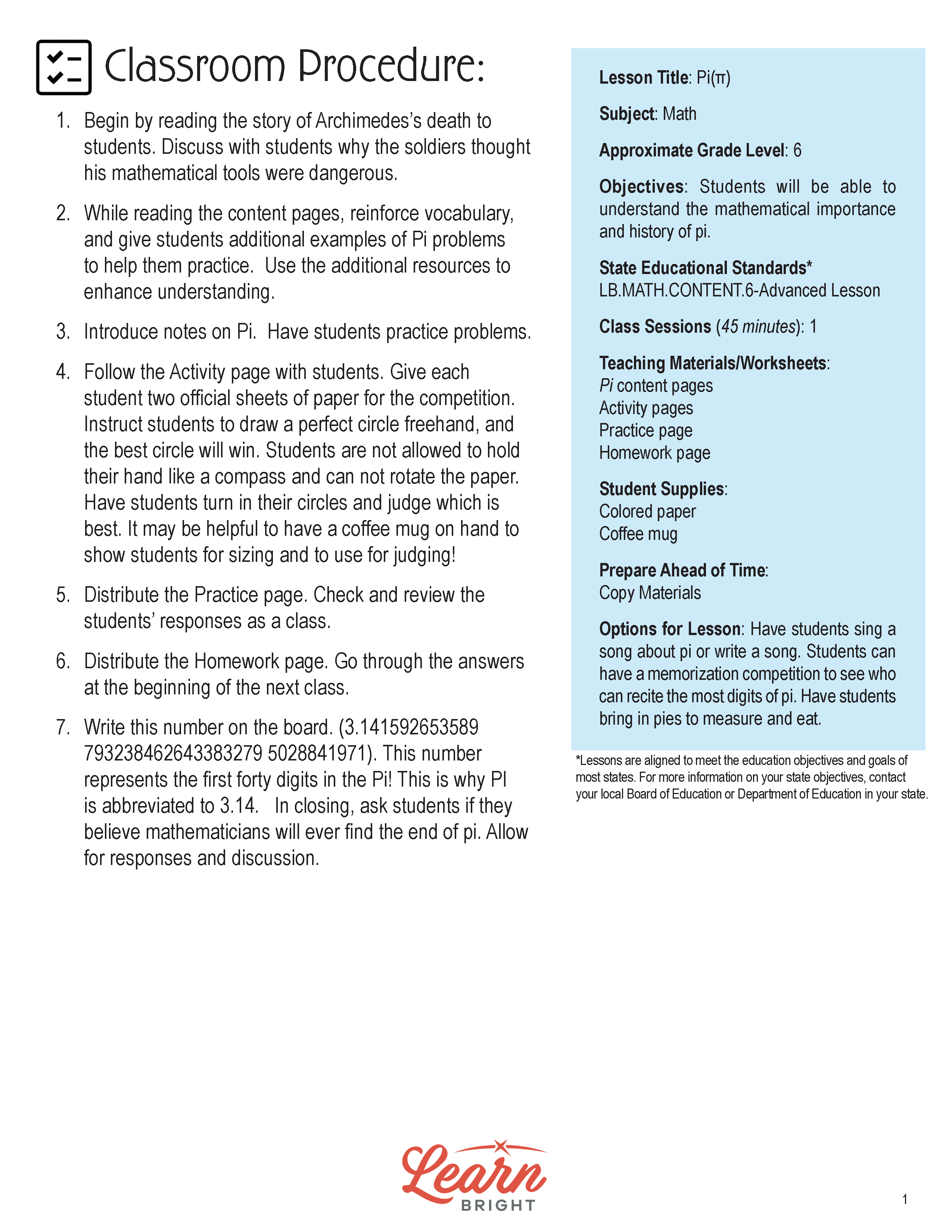Description
What our Pi: Advanced lesson plan includes
Lesson Objectives and Overview: Pi: Advanced introduces the concept and use of Pi to find the area and circumference of a circle. At the end of the lesson, students will be able to understand the mathematical importance and history of pi. This lesson is for students in 6th grade.
Classroom Procedure
Every lesson plan provides you with a classroom procedure page that outlines a step-by-step guide to follow. You do not have to follow the guide exactly. The guide helps you organize the lesson and details when to hand out worksheets. It also lists information in the blue box that you might find useful. You will find the lesson objectives, state standards, and number of class sessions the lesson should take to complete in this area. In addition, it describes the supplies you will need as well as what and how you need to prepare beforehand. The supplies you will need for this lesson include colored paper and a coffee mug.
Options for Lesson
Included with this lesson is an “Options for Lesson” section that lists a number of suggestions for activities to add to the lesson or substitutions for the ones already in the lesson. One optional addition to this lesson is to have your students sing or write a song about pi. You could also hold a class competition to see which student can recite the most digits of pi. Finally, for pi day, you could have your students bring in pies to measure and eat.
Teacher Notes
The teacher notes page includes a paragraph with additional guidelines and things to think about as you begin to plan your lesson. This page also includes lines that you can use to add your own notes as you’re preparing for this lesson.
PI: ADVANCED LESSON PLAN CONTENT PAGES
Pi
The Pi lesson plan includes one page of content. Pi is a mathematical constant represented by a Greek letter (π). Constants never change, which means pi never changes. Pi is the circumference of a circle divided by its diameter. The circumference of a circle is about 3.14 times its diameter.
The constant pi isn irrational number, which means that it never ends and never repeats. It doesn’t matter how many decimal places you look at, it keeps going! Pi is an approximation.
Mathematicians use pi to determine the diameter of a circle if they know the circumference and vice versa. Once you have the diameter of a circle, it’s easy to calculate the area.
Mathematicians have been interested in circles for a long time. The first person to calculate pi was the Archimedes of Syracuse, who lived from 287 – 212 BC. However, they didn’t use the Greek symbol π to represent it until the 1700s. A man named William Jones first used it in 1706, but Leonhard Euler made it famous in 1737.
Because pi is never-ending, not even a supercomputer can find the end. A computer once calculated pi to 1,241,100,000,000 decimal places!
PI: ADVANCED LESSON PLAN WORKSHEETS
The Pi: Advanced lesson plan includes three worksheets: an activity worksheet, a practice worksheet, and a homework assignment. You can refer to the guide on the classroom procedure page to determine when to hand out each worksheet.
CIRCLE ACTIVITY WORKSHEET
For the activity worksheet, students will try to draw a perfect freehand circle without any help.
FIND THE CIRCUMFERENCE PRACTICE WORKSHEET
The practice worksheet asks students to find the circumference of each pie shown on the worksheet.
PI HOMEWORK ASSIGNMENT
For the homework assignment, students will answer seven questions about pi.
Worksheet Answer Keys
This lesson plan includes answer keys for the practice worksheet and the homework assignment. If you choose to administer the lesson pages to your students via PDF, you will need to save a new file that omits these pages. Otherwise, you can simply print out the applicable pages and keep these as reference for yourself when grading assignments.









